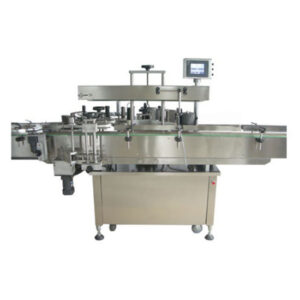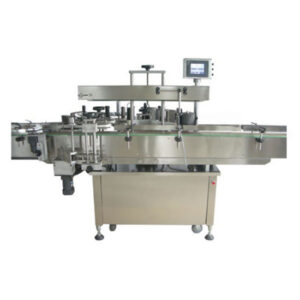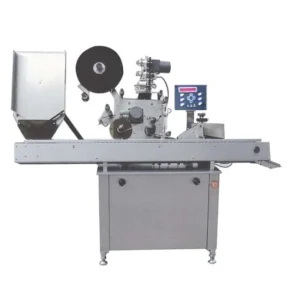Labeling Machine
“You need a labelling machine, and Qualipak Labeling Machine is the best choice for you.” – Very precise labelling is done by this machine. Your packaging process can be simplified by customizing labels that are very accurate and easy to use. Get an upgraded brand image and elevated level of productivity due to the use of this modern technology. For cutting-edge developments in packaging, rely on Qualipak.”
Introduction of Labeling Machine
Labelling machines are essential in various industries, as they enable products to be efficiently and accurately labelled. From food and beverage to pharmaceutical and cosmetic industries, these machines streamline packaging processes while ensuring adherence to regulatory standards and increasing brand exposure. In this all-inclusive guide, the different types of labelling machines, their methods of operation, applications, functions, trends for the future as well as advantages will be explored.
Understanding theLabeling Machine
Various Types of Labeling Machines
Different types of labelling machines exist with each type serving specific labelling purposes. Major groups of labelling machines include:
pressure-sensitive labelling machine: These devices use pressure-sensitive adhesives in applying labels on items. They are versatile since you can attach them to a variety of products such as jars and bottles among others.
Glue-based labelling machine: Adhesive is used by these labellers for their application. They are generally applied where irregularly shaped or non-flat surfaces such as tubes or cans have to be labelled.
Shrink sleeve or sleeve-labeling machine: These devices heat and shrink the sleeve around containers during production to apply ‘shrink sleeves’/ labels on them. They are useful for product visualization as well as tamper-evident packs.
Wrap-around Labeling Machine: Here labels are wrapped around the product so that they can cover every part of a bottle or can hence making a brand visible which is usually done especially in the beverage industry for bottle labelling.
Front/back labelling machine: Front/back labelling machine refers to those that place stickers on both sides of an object at ago. This kind is used when there is branding from either side thus making it easier than having two separate operations done at different times.
Working Processes Involved in Labeling Machines
Label dispensing – The head section holds the labels that fall into position for attachment once fed into it.
Product alignment – To ensure precise application process units move parts along conveyors before feeding them to the labeling machine.
Label application – The labelling head applies labels through pressure, adhesive or heat depending on the kind of labelling machine employed.
Inspection and Quality Control: Some of them are equipped with inspection systems that ensure label accuracy, alignment and quality. These will help in detecting any errors in labelling before packaging and shipping.
Output and Packaging – Labeled products come out from the machine and then they are conveyed to various packing lines for additional processes such as capping, filling or sealing.
Applications of Labeling Machines
Different industries use labelling machines for different tasks including:
Food & Beverage: These machines label bottles, cans, jars etc used for food products like soft drinks, beer, wine, sauces condiments among others
Pharmaceutical & Healthcare: In the pharmaceutical industry there is a need for these types of machinery since they label medicine bottles & vials, syringes and packaging materials used to pack drugs hence ensuring that products comply with regulatory requirements as well as patient safety.
Cosmetics & Personal Care: They are used to mark cosmetic bottles and jars tubes as well as skin care hair care make up personal care products thereby creating brand awareness about it in particular markets
Chemical & Industrial: Chemical containers, jugs drums among other industrial packaging need to be labelled using this type of machines because they offer product identification, safety information & regulatory compliance
Retailer/Consumer Goods: The retailing sector requires these machines to fix labels on consumer items like packaged foods, beverages, household goods more just so that those people who visit their supermarkets can identify them easily when shopping.
Label Application: Labeling machines apply labels to products with precision and consistency, ensuring uniformity in branding and product identification.
Speed and Efficiency: Labeling machines automate the labelling process, increasing production speed and efficiency compared to manual labelling methods.
Accuracy and Precision: By placing labels on products accurately with minimal error, labelling machines help prevent labelling errors as well as materials wastage.
Versatility and Adaptability: These machines can have different sizes of labels as well as accept varied shapes of labels including different types of packaging materials for various products.
Compliance with Regulatory Standards: More crucially, they help manufacturers comply with essential regulatory standards regarding product information such as ingredient lists, nutrition information requirements expiration dates, and safety warnings among others.
Future Trends in Labeling Machines
In this regard, the industry of these machines is changing at a fast pace as it is fueled by technology advancements, market forces, and consumer preferences. What are the future trends in labelling machines? Some future trends may include;
Automation and Integration: The adoption of automation technologies like robotics artificial intelligence machine learning will make labelling more efficient since they will be easily integrated into other packaging aspects without hitches.
Sustainability and Eco-Friendly Solutions: This has pushed innovation in the field of labelling machine technology to feature recyclable labels bio-based materials and reduced packaging waste among others which are sustainable forms promoting environmental conservation.
Smart Labeling Systems: With RFID tags QR codes or NFC technology smart label systems offer traceability authentication and interactive consumer engagement surpassing traditional ways of doing things through traditional labelling processes thereby becoming obsolete.
Digital Printing and Customization: Digital printing capabilities allow for on-demand printing personalized branding shorter print-runs rapid prototyping while still cutting costs and lowering lead times when producing labels using a digital approach only.
Remote Monitoring and Predictive Maintenance: With remote monitoring devices via IoT connectivities link communications systems incorporated inside these devices can actively keep track of performance levels to improve uptime hence OEE optimization maintenance cycles.
Roles and Advantages of Labeling Machines
Various benefits come with labelling machines across several sectors as they also play crucial roles:
Improved Productivity: Since the process is automated, this will result in increased production rates hence higher throughput within the shortest time possible therefore labour costs decrease making it more efficient.
Enhanced Accuracy and Consistency: This minimizes rejects reduces errors during product labelling, product quality maintains brand integrity as well and builds customer trust towards products.
Compliance and Regulatory Compliance: By ensuring compliance with product labels’ regulatory standards, manufacturers avoid penalties and legal actions that may arise from non-compliance.
Brand Visibility and Marketing: Good design can make a difference in terms of brand visibility consumer attention in-store shelf space thus leading consumers to differentiate a given brand from others driving sales growth through loyalty recognition.
Cost Savings and ROI: These can reduce the wastage of materials and labour cost downtime associated with manual methods of applying these thereby resulting in a better return on investment over an extended period.
Frequently Asked Questions (FAQS)
- What are some of the things that labelling machines can be used for?
Labelling machines can be used with a variety of products, which include bottles, jars, cans, tubes, boxes, containers and packaging for foods and drinks, as well as drugs and cosmetics, chemicals and consumer goods.
- How do labelling machines put labels on items?
Labelling machines use pressure-sensitive adhesives (stickers), glue (for wet glue labelling), heat(for shrink sleeves) or wrap-around mechanisms depending on the type of machine being used.
- Can the size and shape of labels be customized in labelling machines?
Yes, many types of labelling machines come with customization features. This means that different sizes shapes and materials can be accommodated by them. It is possible to make adjustments for specific label requirements so long as they relate to product packaging details.
- Why are labelling machines better than manual methods?
Using label applicators instead has several advantages over manual labelling techniques. These include improved productivity levels; higher accuracies; consistency; conformity to regulatory standards; lower labour costs; reduced incidence of mislabelling errors during labelling activities as well and brand exposure promotion.
- Does other packaging equipment get integrated with labelling machines?
Yes, other equipment such as fillers capers sealers conveyor systems may also be utilized together with labellers to form a complete production line. Such integration boosts efficiency as well as overall automation level in packaging.
- Are there any limitations regarding the scale at which these devices operate?
On the contrary, they have been designed to cater for both small-scale and large-scale manufacturing operations. The availability of these devices takes into consideration varying production volumes needed by various industries besides having different formats.
- How is accuracy achieved in labelling machine technology?
Many of them possess inspection system sensors together with precision control that ensures proper alignment thereby providing label accuracy throughout within their limits before finished products get dispatched or packaged.
- Can these apparatuses satisfy diverse kinds of labels like sleeve or front and back labelling?
Yes, they can. These include front and back, sleeve, wrap-around and many other types of labelling requirements. It is possible to configure or customize them to meet the specific labelling needs of different products.
- Are labelling machines eco-friendly?
By reducing the wastage of materials, improving production efficiencies and providing environmentally friendly alternatives such as recyclable labels and bio-based materials, labelling machines can enhance sustainability.
- What are some trends in future machine technology?
Some future trends in this kind of technology will involve automation, smart packaging integration, green initiatives associated with sustainability conditions (Bio-degradable), digital printing customization options (Labeltronix) and remote monitoring as well as predictive maintenance. There is a need for greater efficiency in label production that considers the environment in all labelling activities.



